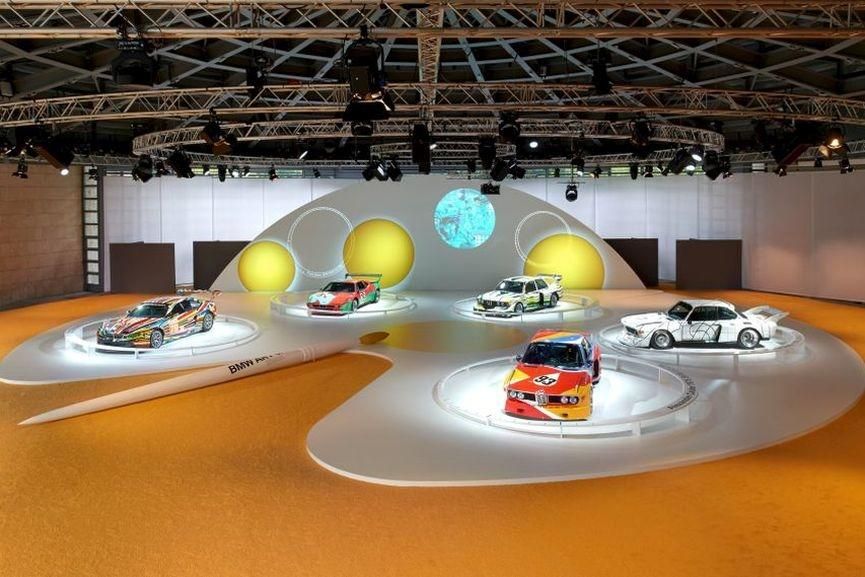Something Unique in the World of Racing: BMW Art Car Project
BMW Art Car Project is a unique collection of 17 BMW cars, both race and road models, designed and created between 1975 and 2010, by some of the most renowned artists ever.
It all began back in 1975, when the French race car driver and art enthusiast Hervé Poulain entered the famous 24 Hours of Le Mans race. Knowing that the podium was out of his reach, he decided to take a different approach and draw attention at LeMans even if he did not do well in the actual race.

Hervé Poulain pictured in 2010 with a miniature of the first Art Car, sitting in front of 2010 Art Car
1975 BMW 3.0 CSL by Alexander Calder – the first Art Car
He asked his friend, an American artist Alexander Calder, to use Poulain’s BMW 3.0 CSL race car as a canvas for his artwork and the first BMW Art car was created.
More than 40 years after that race, Poulain’s race result is forgotten but we have a collection of Art Cars which BMW proudly presents in its own museum and at various exhibitions across the world.
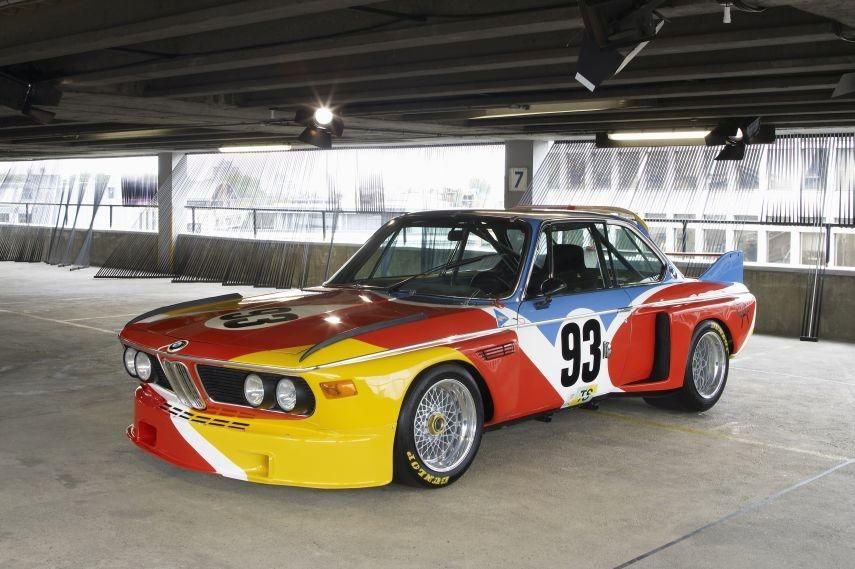
1975 BMW 3.0 CSL by Alexander Calder
Poulain retired in the race with #93 Art Car
Not to be completely forgotten, we will mention that Poulain did not finish the 1975 Le Mans race. His co-drivers were Sam Posey and Jean Guichet, and they retired from the race after seven hours due to driveshaft issues.
The #93 BMW 3.0 CSL never raced again, but it became the moving reminder to the career of Alexander Calder, who died in 1976 and that BMW was his last artwork.
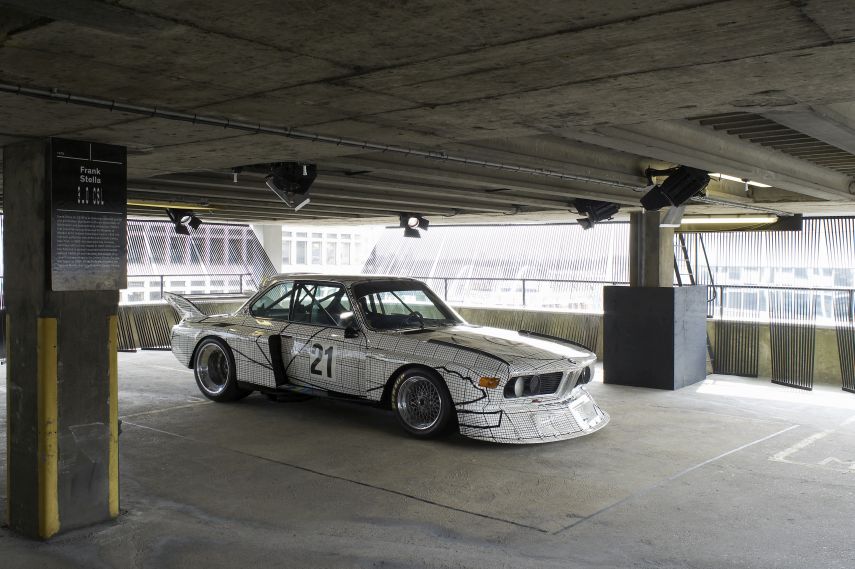
1976 BMW 3.0 CSL by Frank Stella
1976 BMW 3.0 CSL by Frank Stella
The next artist who put his hands on the BMW race car was an American Frank Stella. He created a black and white square grid, the reminiscent of oversized graph paper. This graph paper pattern ran across the entire bodywork, capturing and describing every curve and every indentation.
Stella’s car took part in the 1976 24 Hour of Le Mans but due to technical problems didn’t finish the race. The same thing happened at the 500-km race at the Dijon-Prenois Circuit.
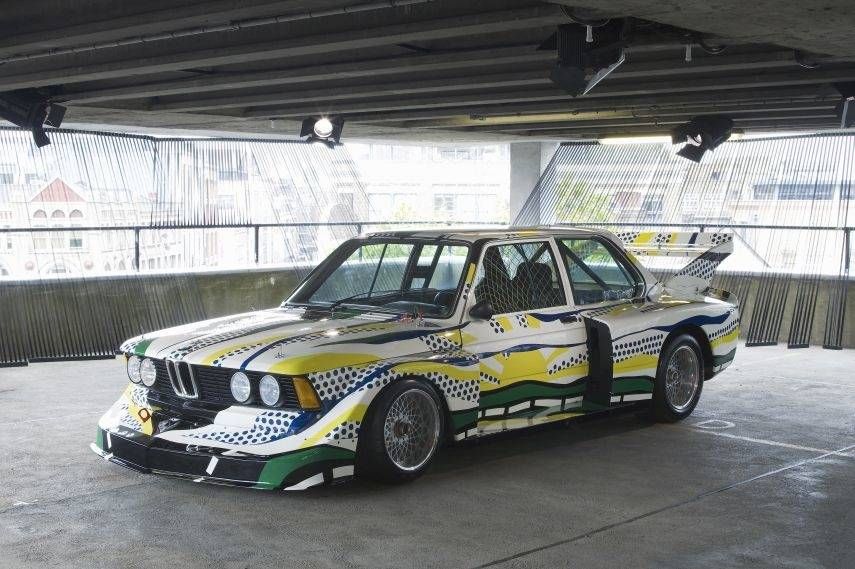
1977 BMW 320i by Roy Lichtenstein
1977 BMW 320i by Roy Lichtenstein
The third Art Car was Roy Lichtenstein’s BMW 320i in 1977. The famous American pop artist gave the car that unique, recognizable design. “I wanted the lines I painted to be a depiction the road showing the car where to go. The design also shows the countryside through which the car has travelled. One could call it an enumeration of everything car experiences – only that this car reflects all of these things before actually having been on a road,” said Roy Lichtenstein commenting on his design.
The Group 5 car was competing at the 1977 24 Hours of Le Mans and it was the first Art Car which actually finished the race. The car with the number 50 was driven by Hervé Poulain and Marcel Mignot and they achieved the ninth place overall.
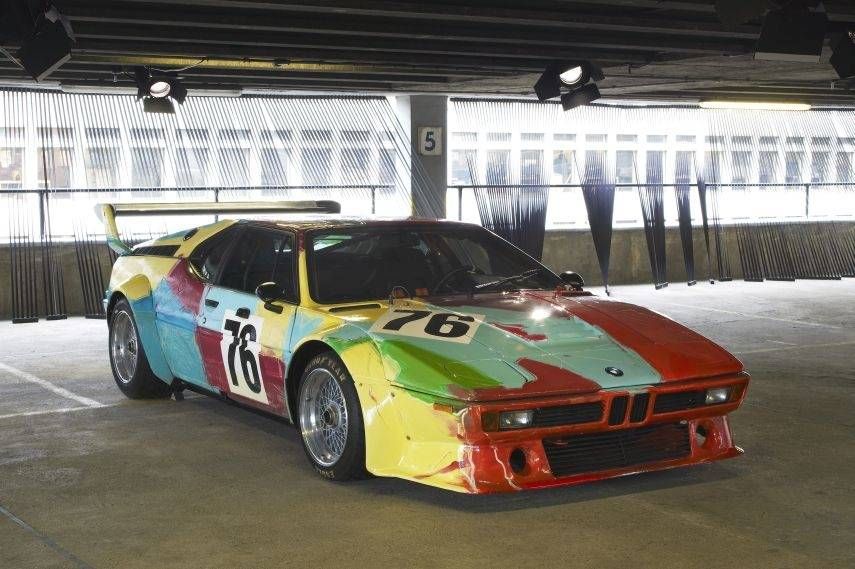
1979 BMW M1 by Andy Warhol
1979 BMW M1 by Andy Warhol – the most famous Art Car
The most famous author of the Art Cars was Andy Warhol, who converted the BMW M1 into artistic moving sculpture. This car is also the most successful of all the Art Cars, as it a achieved a sixth overall position at 1979 24 Hours of Le Mans.
The drivers of the #76 car were Herve Poulain, Marcel Mignot, and Manfred Winkelhock. They completed 288 laps at the Circuit de la Sarthe, coming 6th overall and 2nd in their class.
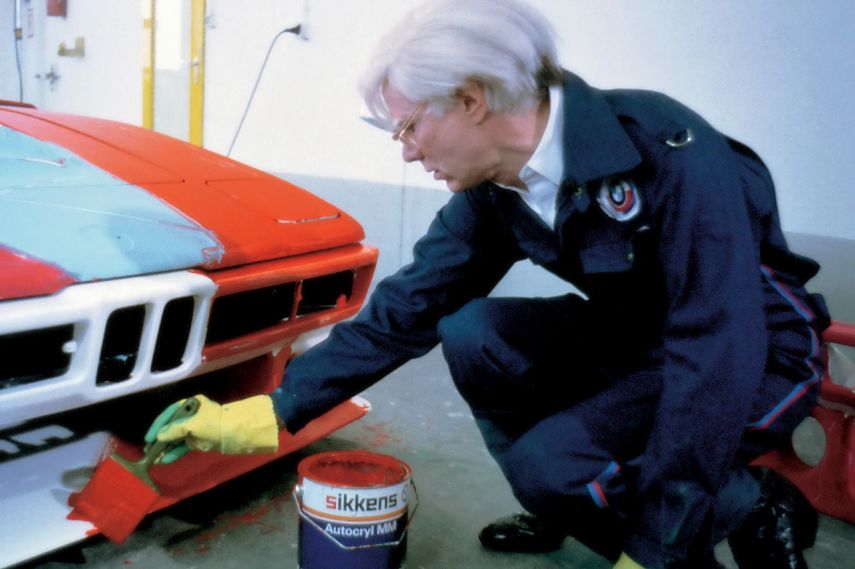
Andy Warhol painted the whole car himself
Warhol did it all by himself
During the race, the car made contact with other cars several times, so the damaged parts were replaced later. Andy Warhol had painted spare bumpers and body panels.
When designing the car, Warhol painted it alone, from the beginning to the end, not leaving the final completion to his assistants as his predecessors did. “I love that car. It has turned out better than the artwork,” Warhol said about his BMW M1.
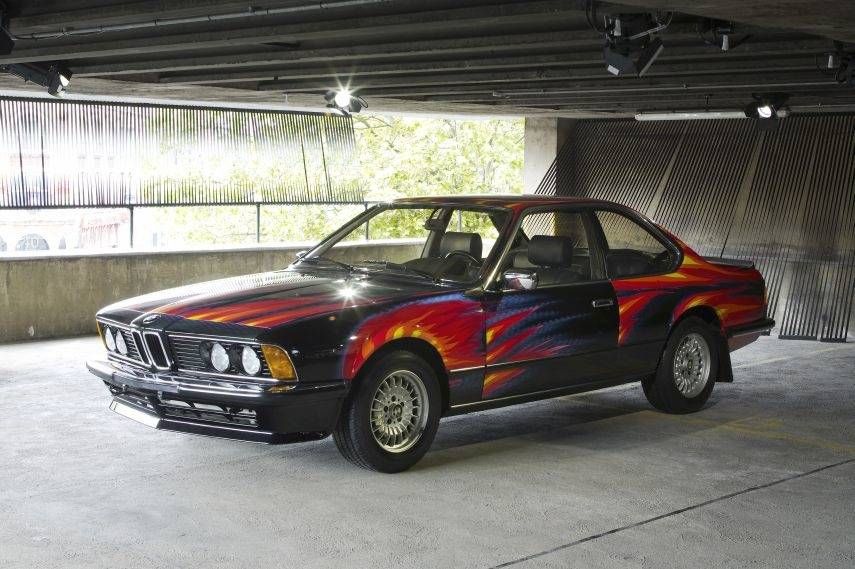
1982 BMW 635 CSi by Ernst Fuchs
1982 BMW 635 CSi by Ernst Fuchs
After four Americans, an Austrian, Ernst Fuchs, was hired to create the fifth Art Car in 1982. Except for the nationality of the artist, the main difference was the fact that he designed the Art Car based on a production car. It was a BMW 635 CSi. The car was just an exhibit, and it never did hit the road.
“I call this car “Fire Fox on a Hare Hunt‟. I see a hare at night running across the “autobahn” and leaping over a burning car – a primeval fear and a bold dream of surmounting a dimension in which we live. It shows me its colours, I read them in its lines, in its contours, I hear its voice calling out emphatically and see that beautiful hare leaping through the flames of love, averting all fears,” Fuchs described his artwork.
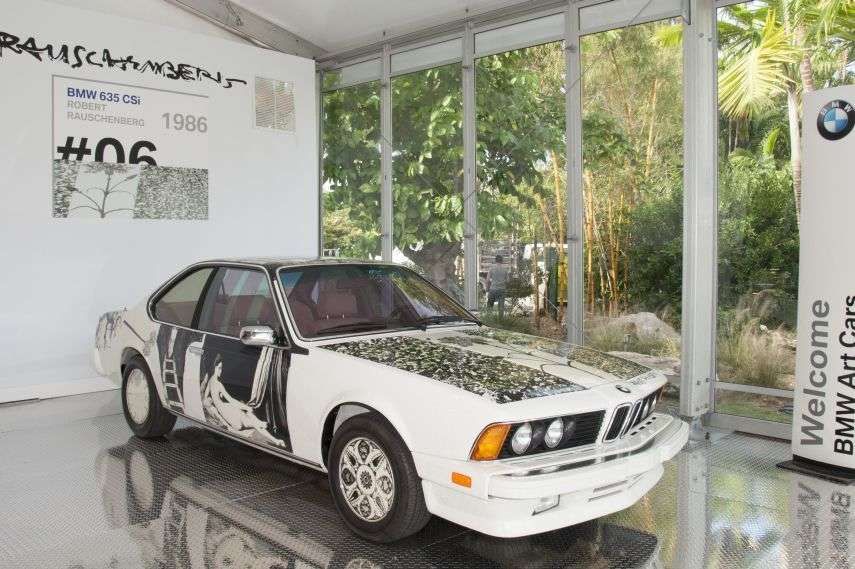
1986 BMW 635 CSi by Robert Rauschenberg
1986 BMW 635 CSi by Robert Rauschenberg
The BMW 635 CSi was again the base car for the creation of the Art Car in 1986. The author was an American painter and graphic artist, Robert Rauschenberg. He was first to use other artists works on his Art Car. On the left side he projected Bronzino‟s “Portrait of a Young Man”, and on the right a painting by Jean Auguste Dominique Ingres.
Rauschenberg’s own photographs of trees and swamp grass point were placed on the engine hood. The “hub caps” are formed using photographs of antique plates. As its predecessor, this car was never driven on the road.
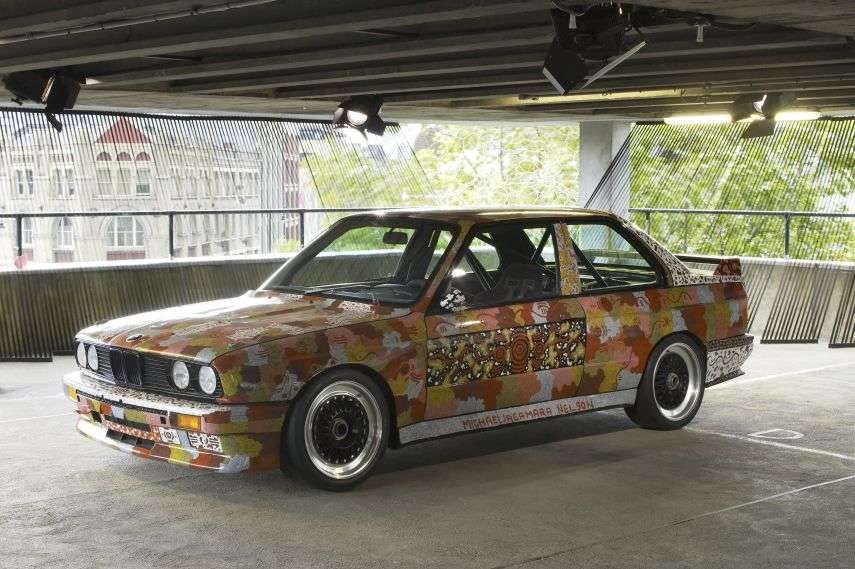
1989 BMW M3 by Michael Jagamara Nelson
1989 BMW M3 by Michael Jagamara Nelson
The two Australian artists were the authors of the seventh and eighth Art Car in 1989. Both were BMW M3 Group A racing cars, which was earlier used by different teams in the various Australian competitions.
An Australian Aborigine, Michael Jagamara Nelson transformed the black BMW M3 into the masterpiece of Papunya art, with kangaroos, emus, and other traditional motives. The car Nelson painted was used by the Frank Gardner‘s JPS Team BMW in the Australian AMSCAR championship, which Tony Longhurst won in 1987. In 1988, the same was used by the Mobil 1 Racing team in the Australian Touring Car Championship and it was driven by the legendary Peter Brock.
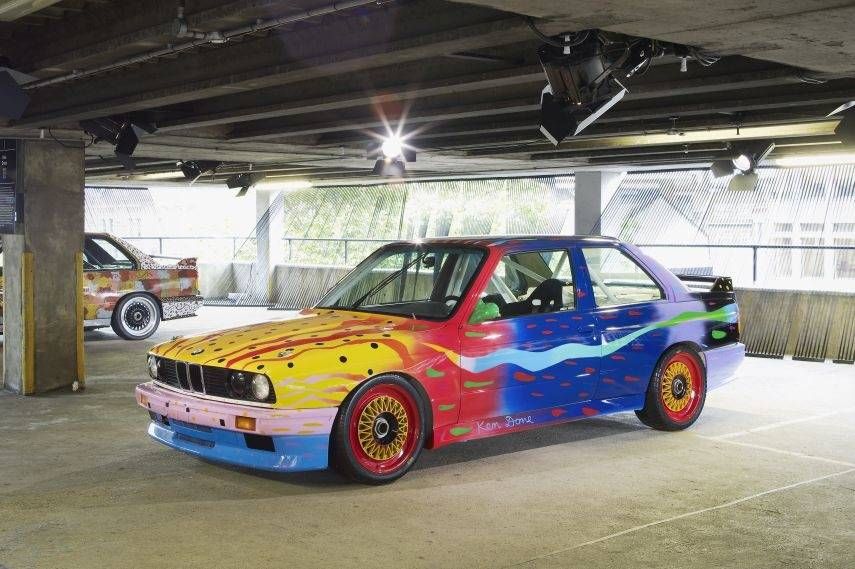
1989 BMW M3 by Ken Done
1989 BMW M3 by Ken Done
The other Australian Art Car was painted by Ken Done. It was characterized by the exotic colours of parrots and parrot fish. Such a design expressed Ken’s fascination for this high-performance car and at the same time it was typically Australian design, which reflects the vitality of his homeland.
The car was used in the 1987 Australian Drivers’ Championship by JPS Team BMW and Jim Richards won the Group A championship. In 1988, the car raced only once.
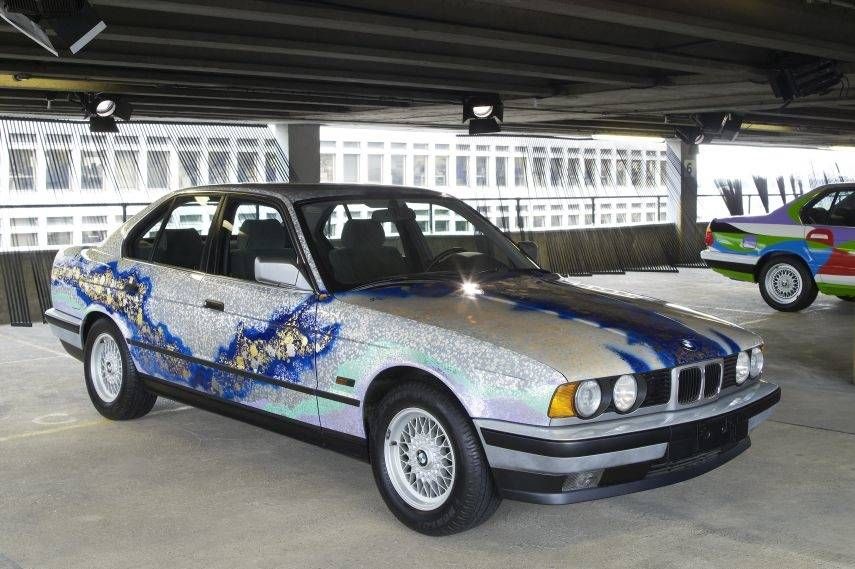
1990 BMW 535i by Matazo Kayama
1990 BMW 535i by Matazo Kayama
Two more Art Cars based on the road models were created in 1990. The Japanese painter Matazo Kayama transformed the BMW 535i into a sculpture, combining the fascination for BMW technology with modern Japan.
He used the airbrush technique and then extremely intricate techniques such as “Kirigane” (metal cutting) and “Arare” (foil print) to cut out small pieces of silver, gold and aluminium foil and transferred them to the bodywork.
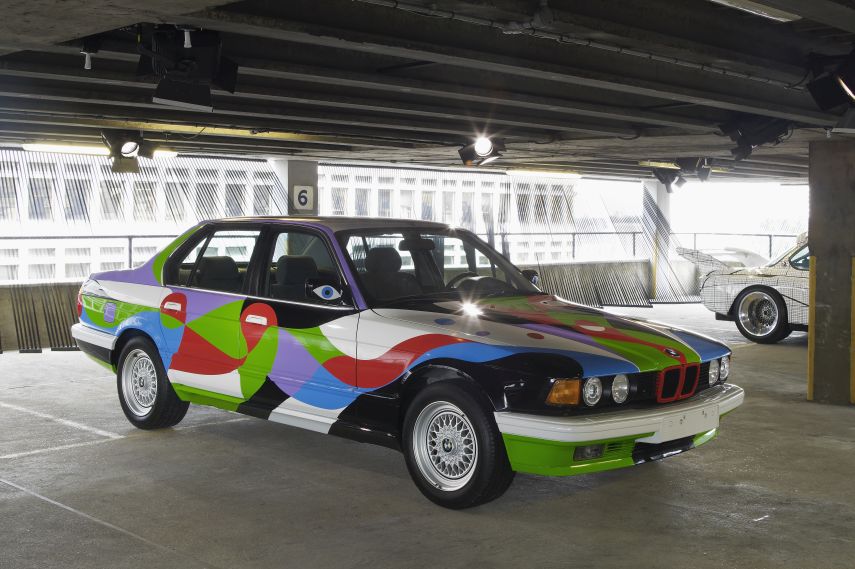
1990 BMW 730i by Cesar Manrique
1990 BMW 730i by Cesar Manrique
Another author of 1990 Art Cars was a Spanish artist and architect, Cesar Manrique. While designing his BMW 730i Art Car, it was Manrique’s intention to unite in a single object the perception of speed and aerodynamics with the concept of aesthetics.
“Therefore, my idea was to design the BMW in such a way as to give the impression of it effortlessly gliding without any resistance,” he said. Neither of the two Art Cars from 1990 made it to the race track.
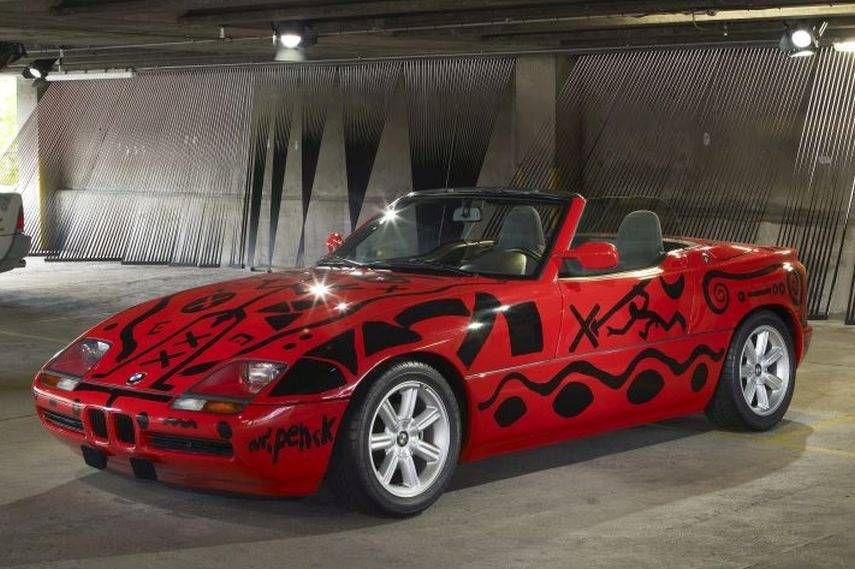
1991 BMW Z1 by A.R. Penck
1991 BMW Z1 by A.R. Penck
The Art Car project continued in 1991, with the German artist Ralf Winkler, alias A.R. Penck. He redesigned the BMW Z1 which was, according to him, already a “work of art” and reflects the creativity and imagination of designers and engineers.
The artist painted the details which remind us of the prehistoric cave paintings. All those figures and signs have some messages inside. The Penck’s Art Car was just an exhibit and it was never driven.
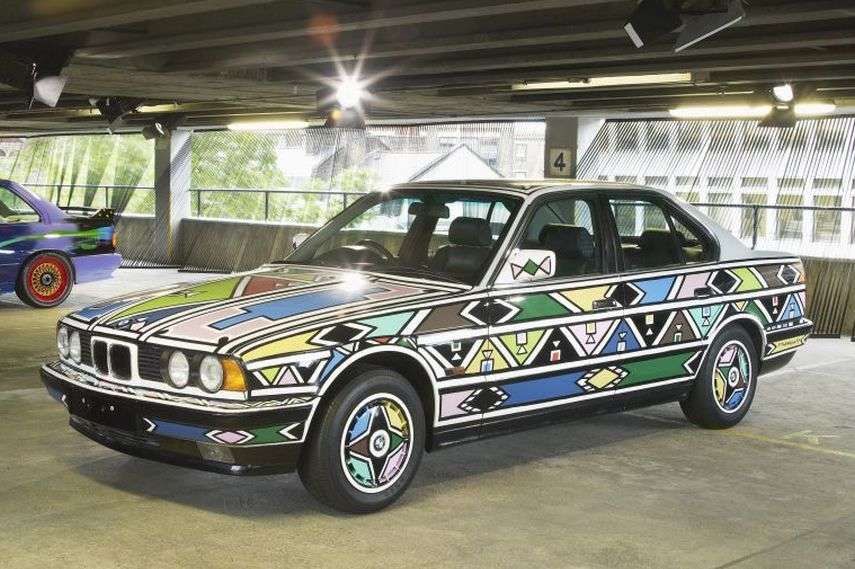
1991 BMW 525i by Esther Mahlangu
1991 BMW 525i by Esther Mahlangu
The first woman included in the project was the South African artist Esther Mahlangu, who created one more Art Car in 1991. His car was a road version of BMW 525i and she transformed the Bavarian limousine to the masterpiece of the African Ndebele art.
“Ndebele art has, in an entirely natural way, something slightly formal but very majestic about itthrough my work I have added the idea of movement,” Esther said.

1992 BMW M3 GTR by Sandro Chia
1992 BMW M3 GTR by Sandro Chia
In 1992, the Art Car was again a racing car, but only the prototype of the BMW M3 GTR, which was never driven in the race. The author who had a chance to express his artistic idea of the race car was an Italian Sandro Chia.
“The automobile is a much-coveted object within our society. It is the centre of attraction. People look at it. This car reflects those looks,” Chia explained all those faces on the car.
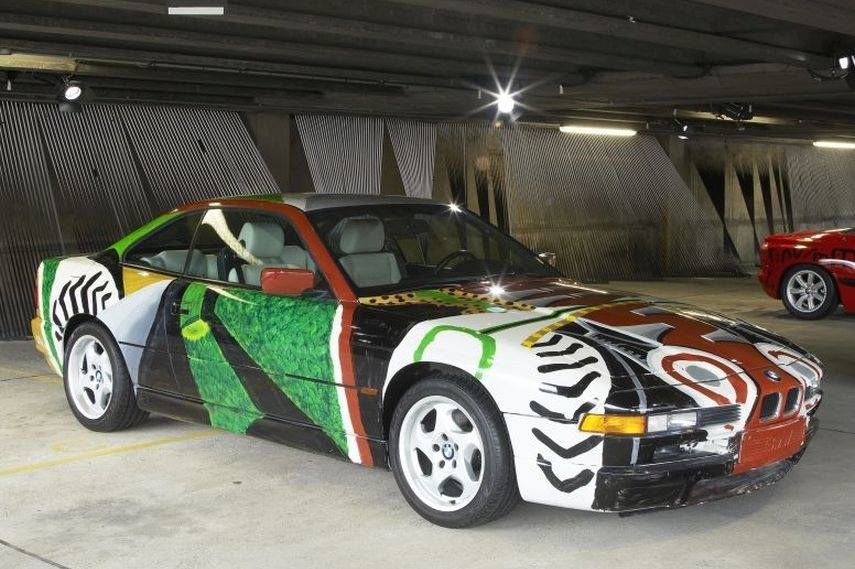
1995 BMW 850 CSi by David Hockney
1995 BMW 850 CSi by David Hockney
The Englishman David Hockney painted the 1995 Art Car. The car of the choice was BMW’s sports coupe 850 CSi. Hockney literally turned the car inside out, making it transparent through its unique perception.
“BMW gave me a model of the car and I looked at it time and time again. Finally, I thought it would be a good idea to show the car as if one could see inside,” Hockney explained.
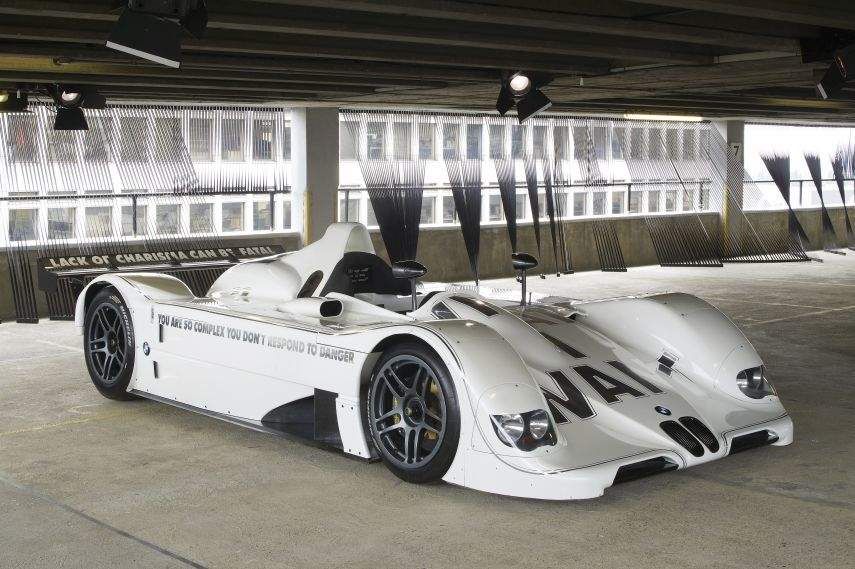
1999 BMW V12 LMR by Jenny Holzer
1999 BMW V12 LMR by Jenny Holzer
In 1999, an American concept artist Jenny Holzer designed the Art Car based on the BMW V12 LMR prototype, developed for the participation at the Le Mans 24-hour race. This car actually participated in the preliminary qualification for the main race but didn’t take part in the race. However, a similar car of BMW Motorsport, with Joachim Winkelhock, Yannick Dalmas and Pierluigi Martini as the drivers, won the race.
Jenny Holzer’s concept is based on traditional colours and materials used in motor racing, but she used reflecting chrome letters and phosphorescent colours to remain her special messages visible during the 24-hour race. During the day the sky is reflected in the letters, during the night the foil is desorbing again the saved daylight in blue.
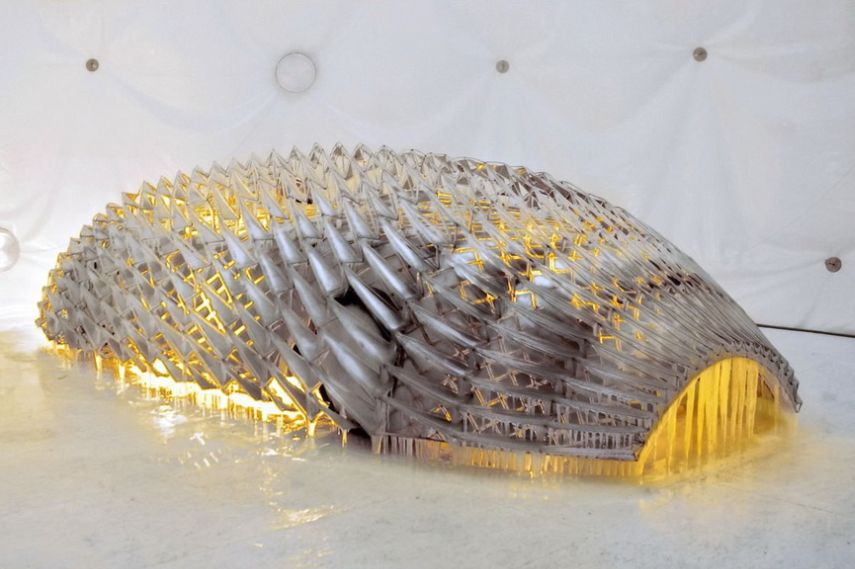
BMW H2R research prototype vehicle by Olafur Eliasson
2007 BMW H2R by Olafur Elliason
In 2007, Danish-Icelandic artist Olafur Eliasson presented something completely different. His Art Car BMW H2R was the research prototype vehicle with a hydrogen-powered engine. The BMW H2R prototype was driven at the test track at Miramas (France) and it established nine records for the hydrogen-powered cars, proving that hydrogen can replace conventional fuels.
Eliasson’s sculpture doesn’t look like a car, as he replaced the body panels with two reflecting layers of superimposed metal. This shape is covered with fragile layers of ice. Eliasson transformed an object of advanced automobile technology and industrial design into a work of art reflecting themes of mobility, renewable energies and the relationship between cars and global warming.
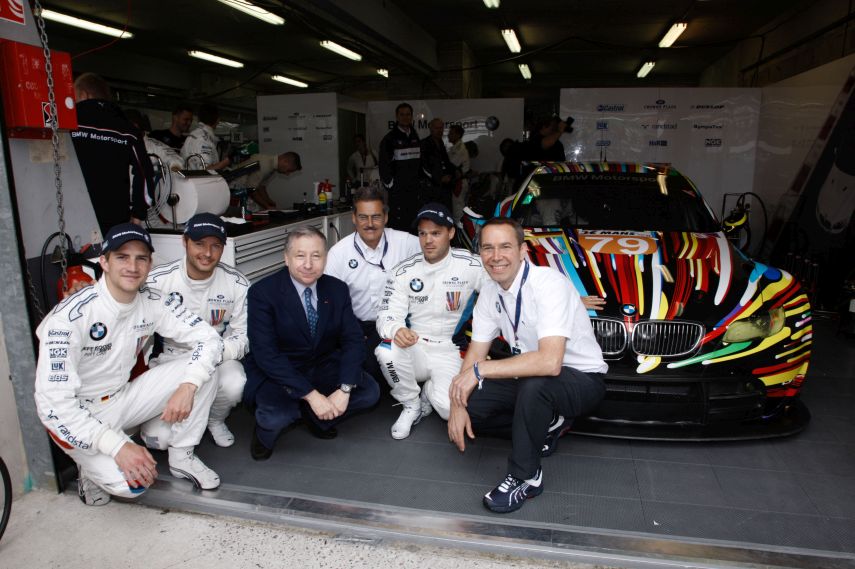
Jeff Koons (right) with Jean Todt, Mario Theissen and the drivers of his BMW M3 GT2 Art Car at 2010 Le Mans race
2010 BMW M3 GT2 by Jeff Koons
The last (or not?) Art Car was Jeff Koons‘ BMW M3 GT2, a race car developed for the participation at 2010 Le Mans 24-hour race. It marked the return of the Art Car project at Le Mans after 30 years of absence.
After its world premiere on June 2, 2010, at the Centre Pompidou in Paris, the BMW Art Car competed at the 24 Hours of Le Mans ten days later. The number 79 on the car was a tribute to Andy Warhol’s car from 1979, which was the last Art Car at Le Mans. The M3 GT2 was driven by Andy Priaulx, Dirk Müller, and Dirk Werner. They struggled with technical problems and had to retire after 53 laps and only five hours of racing.
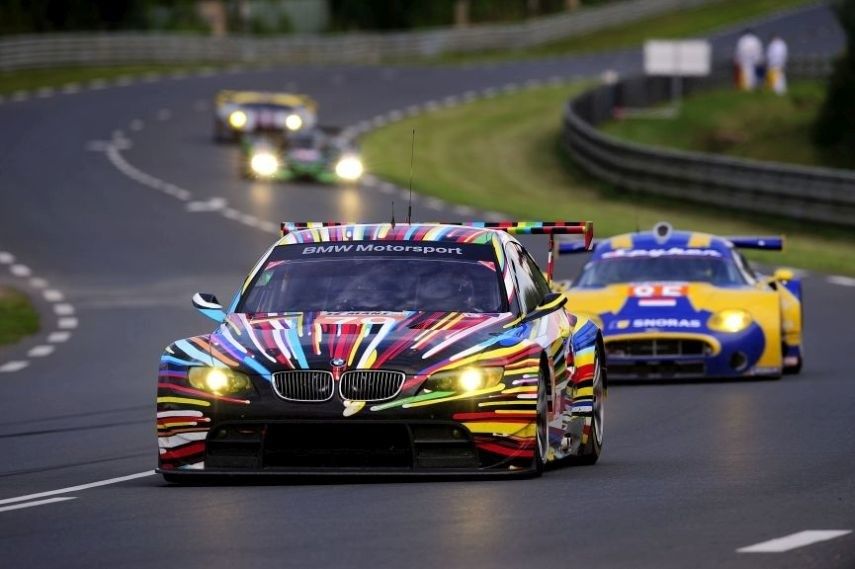
Andy Priaulx, Dirk Muller, and Dirk Werner didn’t reach the finish with BMW M3 GT2 Art Car
Unofficial Art Cars
There are some additions to the story about BMW Art Cars. In 2009, Robin Rhode was chosen to participate in the Art Car project but he didn’t create the car. His idea was to apply the paint to the car’s tyres and drive the BMW Z4 over the giant canvas to create the big painting.
Stella’s second Art Car created in a memory of Ronnie Peterson
Few unofficial Art Cars were created during the years. The famous is the BMW M1 Procar which Frank Stella painted in 1979 for his friend and famous racing driver, Peter Gregg. The car is part of Frank Stella’s “Polar Coordinates” series, created to commemorate the death of Stella’s friend Ronnie Peterson, who died after an accident at Grand Prix race at Monza in 1978.
The other unofficial BMW Art Cars are Keith Haring’s BMW Z1 from 1987, Andy Reubens BMW 3 Series in 2013 and few cars of Walter Maurer, who was an associate to the Art Car authors during 1970s and 1980s and he created some cars on his own.
Photos: Press BMW Group, bmwartcarcollection.com,


